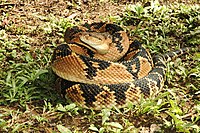Lachesis muta
| Lachesis muta | ||||||||||||||||||||
|---|---|---|---|---|---|---|---|---|---|---|---|---|---|---|---|---|---|---|---|---|
 | ||||||||||||||||||||
| Scientific classification | ||||||||||||||||||||
| ||||||||||||||||||||
| Binomial name | ||||||||||||||||||||
| Lachesis muta (Linnaeus, 1766) | ||||||||||||||||||||
| Synonyms | ||||||||||||||||||||
|
Lachesis muta is a venomous pit viper species found in South America. Two subspecies are currently recognized, including the typical form described here.[2]
Common names: South American bushmaster, more.
Description
Adults grow to an average of 2 to 2.5 m, although 3 m is not too unusual. The largest recorded specimen was almost 3.65 m long, making this the largest of all pit vipers and the longest venomous snake in the western hemisphere.[3]
The head is broad and very distinct from the narrow neck. The snout is broadly rounded. There is no canthus. A pair of small internasals is present, separated by small scales. The supraoculars are narrow. Other parts of the crown are covered with very small scales. Laterally, the second supralabial forms the anterior border of the loreal pit, while the third is very large. The eye is separated from the supralabials by 4-5 rows of small scales.[4]
The body is cylindrical, tapered and moderately stout. Midbody there are 31-37 nonoblique rows of dorsal scales which are heavily keeled with bulbous tubercles and feebly imbricate. There are 200-230 ventral scales. The tail is short with 32-50 mainly paired subcaudals, followed by 13-17 rows of small spines and a terminal spine.[4]
The color pattern consists of a yellowish, reddish or grey-brown ground color, overlaid with a series of dark brown or black dorsal blotches that form lateral inverted triangles of the same color. The lateral pattern may be precisely or indistinctly defined, normally pale at the center.[3]
Common names
South American bushmaster. Known as the mapepire zanana or mapepire grande (pronounced ma-pa(y)-PEE za-Na-na or ma-pa(Y)-PEE GRAN-dey) in Trinidad and Tobago.[5][6]
Etymology
Lachesis is one of the three Fates in Greek mythology and was supposed to assign to man his term of life -- something this species is certainly capable of doing. The species is similar in appearance to rattlesnakes and vibrates its tail vigorously when alarmed, but has no rattle and was therefore called mutus (later muta), which is Latin for dumb or mute. However, when in the undergrowth, the tail actually makes quite a loud rustling noise.[7]
Geographic range
Found in South America in the equatorial forests east of the Andes: Colombia, eastern Ecuador, Peru, northern Bolivia, eastern and southern Venezuela, Guyana, Surinam, French Guiana and much of northern Brazil. The type locality is "Surinami" (Surinam).[1]
The species is also found on the Island of Trinidad.[6]
Habitat
Occurs in primary and secondary forests; adjacent fields and cleared areas.[3] In Trinidad it tends to prefer hilly and mountainous regions.[8]
Venom
Some reports suggest that this species produces a large amount of venom that is weak compared to some other vipers.[9] Others, however, suggest that such conclusions may not be accurate. These animals are badly affected by stress and often do not last long in captivity. This makes it difficult to obtain "good, healthy" venom for study purposes. For example, Bolaños (1972) observed that venom yield from his specimens fell from 233 mg to 64 mg while they remained in his care. As the stress of being milked regularly has this effect on venom yield, it is reasoned that it may also affect venom toxicity. This may explain the disparity described by Hardy and Haad (1998) of the low laboratory toxicity versus the high mortality rate of bite victims.[10]
Brown (1973) gives the following LD50 values for mice: 1.5 mg/kg IV, 1.6–6.2 mg/kg IP, 6.0 mg/kg SC. He also mentions a venom yield of 200-411 mg.[11]
Subspecies
| Subspecies[2] | Authority[2] | Common name | Geographic range[1] |
|---|---|---|---|
| L. m. muta | (Linnaeus, 1766) | South American bushmaster | Colombia, eastern Ecuador, Peru, northern Bolivia, eastern and southern Venezuela, Guyana, Surinam, French Guiana and much of northern Brazil |
| L. m. rhombeata | (Wied-Neuwied, 1824) | Atlantic forest bushmaster | Coastal forests of southeastern Brazil (from southern Rio Grande do Norte to Rio de Janeiro). |
Attribution
- Some content on this page may previously have appeared on Wikipedia.
Cited references
- ↑ 1.0 1.1 1.2 McDiarmid RW, Campbell JA, Touré T. 1999. Snake Species of the World: A Taxonomic and Geographic Reference, vol. 1. Herpetologists' League. 511 pp. ISBN 1-893777-00-6 (series). ISBN 1-893777-01-4 (volume).
- ↑ 2.0 2.1 2.2 Lachesis muta (TSN 209556). Integrated Taxonomic Information System. Accessed on 25 October 2006.
- ↑ 3.0 3.1 3.2 Mehrtens JM. 1987. Living Snakes of the World in Color. New York: Sterling Publishers. 480 pp. ISBN 0-8069-6460-X.
- ↑ 4.0 4.1 U.S. Navy. 1991. Poisonous Snakes of the World. US Govt. New York: Dover Publications Inc. 203 pp. ISBN 0-486-26629-X.
- ↑ Mendes, John. 1986. Cote ce Cote la: Trinidad & Tobago Dictionary, Arima, Trinidad, p. 95.
- ↑ 6.0 6.1 List of Snakes of Trinidad and Tobago at Republic of Trinidad and Tobago Biodiversity Clearing House. Accessed 25 October 2006.
- ↑ Gotch AF. 1986. Reptiles -- Their Latin Names Explained. Poole, UK: Blandford Press. 176 pp. ISBN 0-7137-1704-1.
- ↑ Herklots GAC. 1961. The Birds of Trinidad and Tobago. Collins, London, p. 10.
- ↑ Lachesis muta, The Silent Fate at South American Pictures. Accessed 26 October 2006.
- ↑ Ripa, D. 2001. Bushmasters and the Heat Strike at VenomousReptiles.org. Accessed 26 October 2006.
- ↑ Brown JH. 1973. Toxicology and Pharmacology of Venoms from Poisonous Snakes. Springfield, Illinois: Charles C. Thomas. 184 pp. LCCCN 73-229. ISBN 0-398-02808-7.